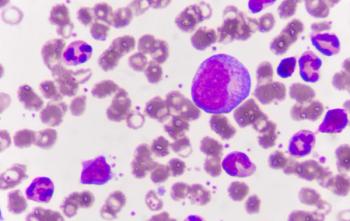
Pulmonary Hypertension in Myelofibrosis: Risks and Treatments
Certain patients with myelofibrosis may be at higher risk for pulmonary hypertension, according to recent research.
There may be certain factors that put a patient with myelofibrosis at a higher risk for pulmonary hypertension, according to Juan C. Lopez-Mattei, MD, FACC, FASE, FSCCT, FSCMR.
Lopez-Mattei, a multimodality imaging cardiologist and associate professor of cardiology and diagnostic imaging at The University of Texas MD Anderson Cancer Center, was the lead author of an analysis that examined 143 patients with myelofibrosis who received an echocardiograph. Fourteen percent had findings that were consistent with pulmonary hypertension.
Patients at Higher Risk
Findings showed that females and those with N-terminal prohormone brain natriuretic peptide (BNP) were significant predictors of hypertension. Lopez-Mattei explained that there is an underestimation of pulmonary hypertension due to left-side heart disease, so evaluating respiratory symptoms and elevated N-terminal prohormone BNP should prompt an echocardiogram.
“We did a deep dive looking at the diastolic parameters, or the relaxation parameters, by echocardiogram to asses whether these patients could have some sort of pulmonary hypertension or secondary to left heart disease (LHD) because of the risk factors of the age range that these patients tend to have,” Lopez-Mattei said in an interview with OncLive, a sister publication of Oncology Nursing News.
“We found that the most common cause of pulmonary hypertension was secondary to LHD or diastolic dysfunction permanently, which is not a surprise based on the comorbidities of the patients in our study.”
Patient characteristics that were associated with pulmonary hypertension included:
- Older age
- Coronary artery disease
- Larger left atrium
There were similar risk factors between patients with heart failure who have preserved ejection fraction and pulmonary hypertension.
“However,” Lopez-Mattei added, “they also have the parameters that are the surrogates of the diastolic function that are abnormal in the majority of patients with pulmonary hypertension. If you put all of that into context, then you can understand why we have to look at patient risk factors regardless of whether or not they have myelofibrosis, because sometimes they need better blood pressure control.”
Pulmonary Hypertension May Affect Outcomes
Lopez-Mattei said that there is a higher mortality signal in patients with myelofibrosis who also have pulmonary hypertension.
But having the comorbidity does not usually affect the treatment that these patients receive for myelofibrosis.
“In some patients with MPNs, there are some drugs that could cause some cardiovascular adverse events. We did not find that any [drugs] in pulmonary hypertension were tied to worsening outcomes,” Lopez-Mattei said.
It is important that the oncology team works with a cardiology team to best treat patients with myelofibrosis and pulmonary hypertension.
“We have a close collaboration with pulmonologists because we both take care of this patient. Our [collaborative] approach has a lot of success because we have varied perspectives,” Lopez-Mattei said.
A version of this article was originally published on OncLive as, “
Newsletter
Knowledge is power. Don’t miss the most recent breakthroughs in cancer care.

















































































